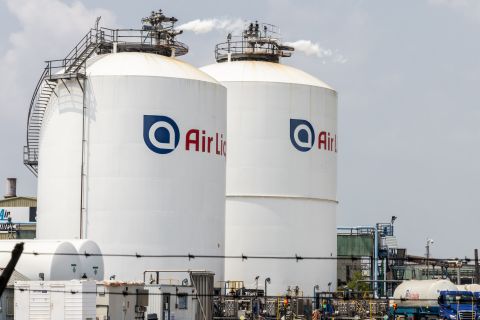
Pioneer Natural Resources CEO Tim Dove speaks during Hart Energy's DUG Eagle Ford conference and exhibition in 2014. (Source: Hart Energy)
Pioneer Natural Resources Co. (NYSE: PXD), one of the Midland Basin’s biggest acreage holders, plans to roll out more high-intensity completions after its latest design pushed production higher in the Permian.
But the company is not taking a “cookie-cutter” approach, according to CEO Tim Dove.
The so-called Version 3.0+ is the higher intensity completion that follows the previous version, which featured proppant concentrations of about 2,000 pounds per foot (lbs/ft), fluid concentrations of up to 50 barrels per foot (bbl/ft), 15-ft cluster spacing and 100-ft stage spacing.
Speaking on an earnings call Aug. 8 with analysts, Dove highlighted a three-well pad targeting the Wolfcamp D in the southern joint venture area that saw a 75% improvement in production with the latest version compared to techniques used three to four years ago.
“We continue to show impressive performance,” Dove said.
In 2015 Pioneer said it was putting its Version 2.0 completion design to work, pumping about 1,400 lbs/ft of proppant and 36 bbl/ft of fluids with 30-ft cluster spacing and 150-ft stage spacing in some parts of the basin. On Aug. 7 the company reported results from 65 Version 3.0+ wells completed in 2017 and first-half 2018 that are “outperforming production from nearby offset wells with less intense completions.”
Giving the positive results, Pioneer said it intends to add 60 more Version 3.0+ completions during second-half 2018 along with four more rigs in the basin as it further tailors completions by well, zone and area for optimal capital efficiency. The increased rig count is not expected to impact 2018 production, considering executives said wells drilled by the additional rigs won’t be completed until January 2019.
The plans, combined with rising costs, prompted Pioneer to increase its planned capex for 2018 to between $3.3 billion and $3.4 billion, up from $2.9 billion. Of the increase between 35% and 40% will go toward increased drilling and completions activity with the remainder set aside for rising costs.
But “we’re not going to be using 3.0+ across the whole field because we’ve determined in some areas it’s just unnecessary,” Dove said. “There’s no sense in spending more money on a 3.0+ style completion if we can get it done with a 3.0.”
Results so far have given Pioneer confidence that the additional investment will be “money well spent.”
Although Pioneer said its second-quarter 2018 production was affected by high field line pressures and weather, specifically in the Permian, the company managed to churn out more barrels of oil. Production increased to 328,000 barrels of oil equivalent per day (boe/d), including 280,000 boe/d from the Permian Basin, above the company’s guidance for the quarter of between 312,000 boe/d and 322,000 boe/d.
Production gains, however, didn’t translate to more profit. A derivative loss of $170 million and higher costs contributed to a drop in profit for the Permian player. Pioneer reported on Aug. 7 net income of $63 million for second-quarter 2018, compared to $233 million a year earlier.
For Pioneer, focus remains on drilling low-cost, high-return Permian Basin wells.
The company said it plans to place 19 wells in the Spraberry horizontal appraisal program on production in second-half 2018 as it looks to “determine the optimal long-term development strategy for the Middle Spraberry Shale, Jo Mill and Lower Spraberry Shale.” Hopes are to find the proper sequencing, spacing and staggering of those wells, Dove said.
The first six of these wells—deployed with the new, larger completions in areas where such techniques have been successful or new areas where the odds of success are favorable—have already been put online. Pioneer plans to share more information on these wells on its third-quarter earnings call.
Years of experience and lessons learned from having drilled about 1,000 wells in the basin have proven the same technique doesn’t work everywhere, according to Pioneer executives.
“We have a dozen-plus different [completion] recipes,” Joey Hall, executive president of Permian operations for Pioneer, said before speaking about tests underway. “The way I’m completing my Middle Spraberry is with 2,500 lbs/ft, the Joe Mills with 1,400 lbs/ft—so nearly half—and the lower Spraberry shale with 2,500 lbs/ft. With the 3.0+ they’re 2,500 lbs/ft. Plus, we’re still doing some that are 1,700 lbs/ft.”
The company is also taking a tailored development approach for the Wolfcamp A and Wolfcamp B as it works to avoid depletion and interference. There are three different options, Hall explained to analysts. When time is not of the essence, Wolfcamp A and Wolfcamp B can be drilled independently. However, there are areas where Wolfcamp A should be drilled within nine months to a year after drilling Wolfcamp B. In addition, there are cases in which both should be drilled simultaneously and zipper fracked, Hall said.
Like the completions recipe, “it’s going to vary across the field,” Hall said, adding the driving factors are thickness and whether a frack barrier is present.
Pioneer expects to grow Permian Basin production by 19% to 24% compared to 2017 levels. Third-quarter guidance is between 278,000 boe/d and 288,000 boe/d.
Velda Addison can be reached at vaddison@hartenergy.com.
Recommended Reading
Air Products Sees $15B Hydrogen, Energy Transition Project Backlog
2024-02-07 - Pennsylvania-headquartered Air Products has eight hydrogen projects underway and is targeting an IRR of more than 10%.
ConocoPhillips EVP of Strategy, Sustainability, Technology Macklon to Retire
2024-02-16 - Dominic Macklon, who began his career with Conoco in 1991, is set to retire ConocoPhillips May 1.
enCore Energy Appoints Robert Willette as Chief Legal Officer
2024-02-01 - enCore Energy’s new chief legal officer Robert Willette has over 29 years of corporate legal experience.
Air Liquide Eyes More Investments as Backlog Grows to $4.8B
2024-02-22 - Air Liquide reported a net profit of €3.08 billion ($US3.33 billion) for 2023, up more than 11% compared to 2022.
Magnolia Oil & Gas Hikes Quarterly Cash Dividend by 13%
2024-02-05 - Magnolia’s dividend will rise 13% to $0.13 per share, the company said.






